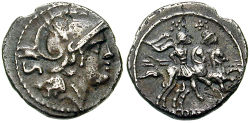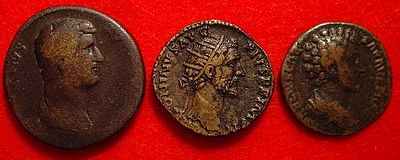as a few of these coins have been found by some members on D.W. thought i would put up a bit of the history of the sestertius........................

elmed Roma head right, IIS behind Dioscuri riding right, ROMA in linear frame below. RSC4, C44/7, BMC13.
AR 0.96 g - RSC4, C44/7, BMC13

Example of a detailed portrait of Hadrian 117 to 138

Hostilian under Trajan Decius 250 AD
The sestertius, or sesterce, was an ancient Roman coin. During the Roman Republic it was a small, silver coin issued only on rare occasions. During the Roman Empire it was a large brass coin.
The name sestertius (originally semis-tertius) means "2 ½", the coin's original value in asses, and is a combination of semis "half" and tertius "third", that is, "the third half" (0 ½ being the first half and 1 ½ the second half) or "half the third" (two units plus half the third unit, or halfway between the second unit and the third). Parallel constructions exist in Danish with halvanden (1 ½), halvtredje (2 ½) and halvfjerde (3 ½). The form sesterce, derived from French, was once used in preference to the Latin form, but is now considered old-fashioned.
The sestertius was introduced ca. 211 BC as a small silver coin valued at one-quarter of a denarius (and thus one hundredth of an aureus). A silver denarius was supposed to weigh about 4.5 grams, valued at ten grams, with the silver sestertius valued at two and one-half grams. In practice, the coins were usually underweight.
When the denarius was retariffed to sixteen asses (due to the gradual reduction in the size of bronze denominations), the sestertius was accordingly revalued to four asses, still equal to one quarter of a denarius. It was produced sporadically, far less often than the denarius, through 44 BC.
Hostilian under Trajan Decius 250 AD
In or about 23 BC, with the coinage reform of Augustus, the denomination of sestertius was introduced as the large brass denomination. Augustus tariffed the value of the sestertius as 1/100 Aureus. The sestertius was produced as the largest brass denomination until the late 3rd century AD. Most were struck in the mint of Rome but from AD 64 during the reign of Nero (AD 54–68) and Vespasian (AD 69–79), the mint of Lyon (Lugdunum), supplemented production. Lyon sestertii can be recognised by a small globe, or legend stop), beneath the bust.[citation needed]
The brass sestertius typically weighs in the region of 25 to 28 grammes, is around 32–34 mm in diameter and about 4mm thick. The distinction between bronze and brass was important to the Romans. Their name for brass was orichalcum, a word sometimes also spelled aurichalcum (echoing the word for a gold coin, aureus), meaning 'gold-copper', because of its shiny, gold-like appearance when the coins were newly-struck (see, for example Pliny the Elder in his Natural History Book 34.4).
Orichalcum was considered, by weight, to be worth about double that of bronze. This is why the half-sestertius, the dupondius, was around the same size and weight as the bronze as, but was worth two asses.
Sestertii continued to be struck until the late 3rd century, although there was a marked deterioration in the quality of the metal used and the striking even though portraiture remained strong. Later emperors increasingly relied on melting down older sestertii, a process which led to the zinc component being gradually lost as it burned off in the high temperatures needed to melt copper (Zinc melts at 419 °C, Copper at 1085 °C). The shortfall was made up with bronze and even lead. Later sestertii tend to be darker in appearance as a result and are made from more crudely prepared blanks (see the Hostilian coin on this page).
The gradual impact of inflation caused by debasement of the silver currency meant that the purchasing power of the sestertius and smaller denominations like the dupondius and as was steadily reduced. In the 1st century AD, everyday small change was dominated by the dupondius and as, but in the 2nd century, as inflation bit, the sestertius became the dominant small change. In the 3rd century silver coinage contained less and less silver, and more and more copper or bronze. By the 260s and 270s the main unit was the double-denarius, the antoninianus, but by then these small coins were almost all bronze. Although these coins were theoretically worth eight sestertii, the average sestertius was worth far more in plain terms of the metal they contained.
Some of the last sestertii were struck by Aurelian (270–275 AD). During the end of its issue, when sestertii were reduced in size and quality, the double sestertius was issued first by Trajan Decius (249–251 AD) and later in large quantity by the ruler of a breakaway regime in the West called Postumus (259–268 AD), who often used worn old sestertii to overstrike his image and legends on. The double sestertius was distinguished from the sestertius by the radiate crown worn by the emperor, a device used to distinguish the dupondius from the as and the antoninianus from the denarius.
Eventually, the inevitable happened. Many sestertii were withdrawn by the state and by forgers, to melt down to make the debased antoninianus, which made inflation worse. In the coinage reforms of the 4th century AD, the sestertius played no part and passed into history.

Sestertius of Hadrian, dupondius of Antoninus Pius, and as of Marcus Aurelius
